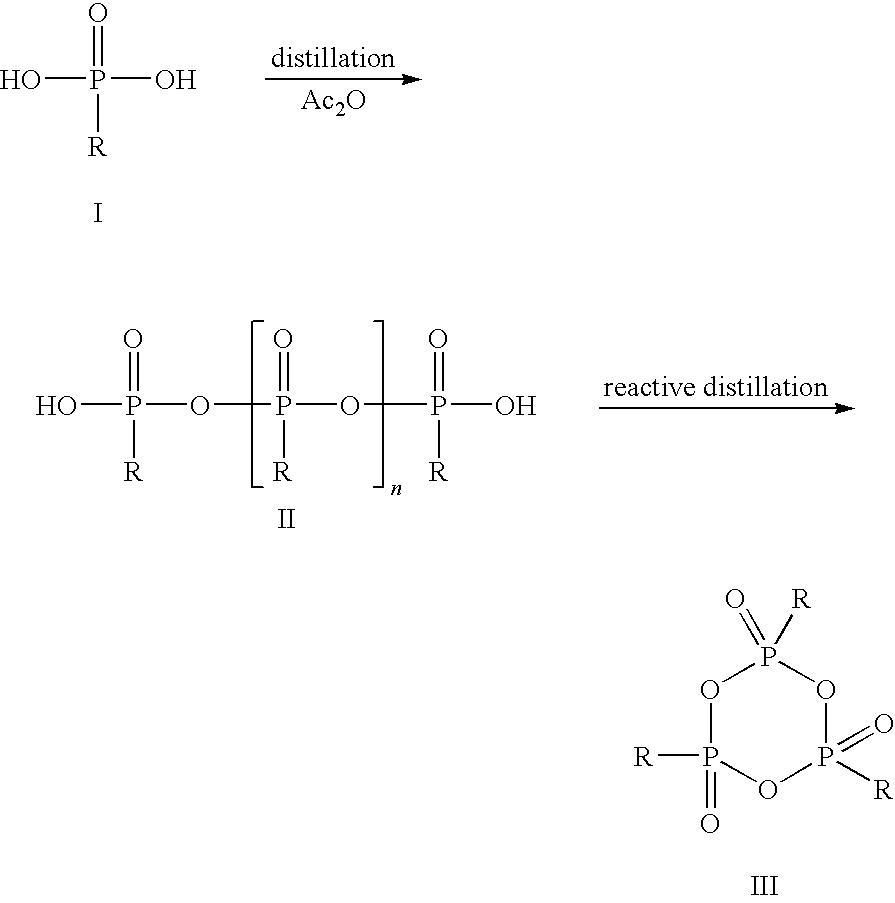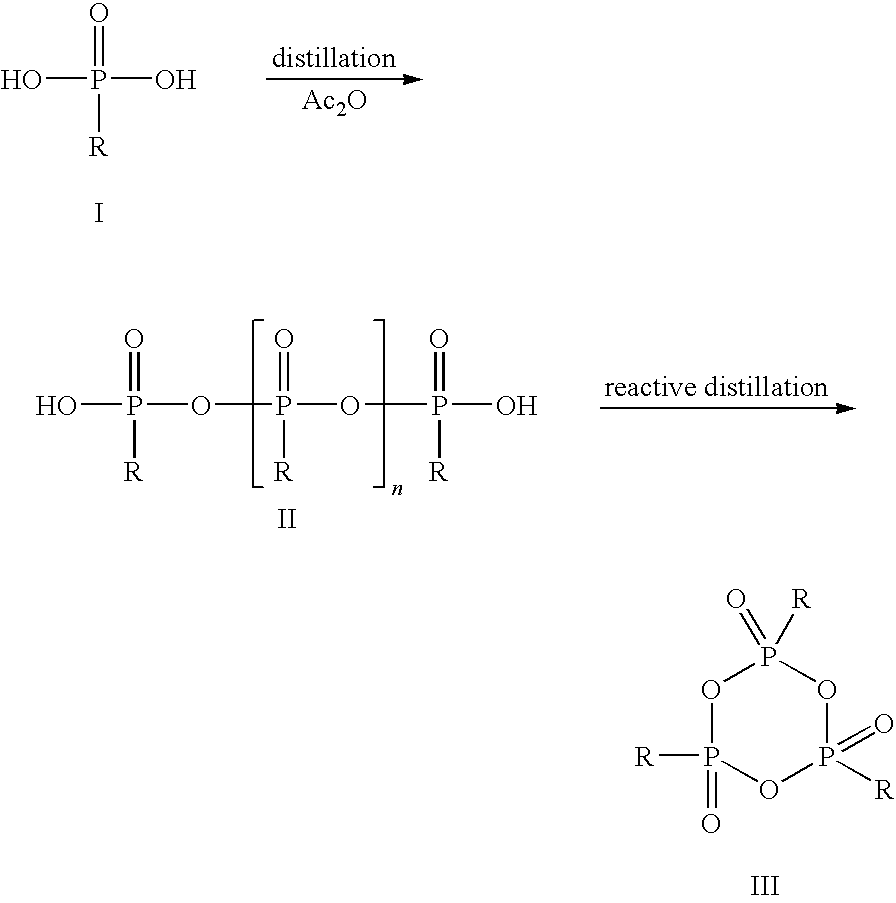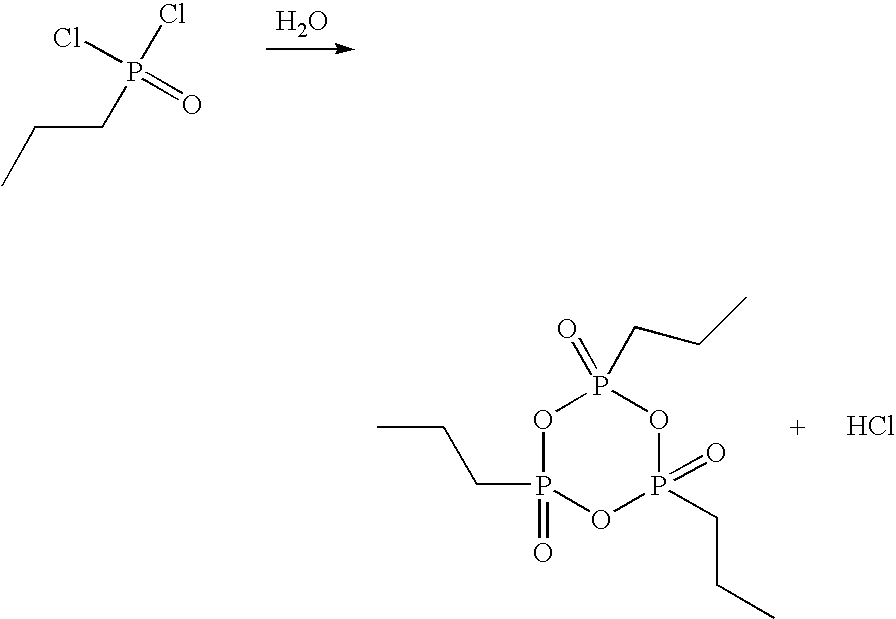Method for the production of cyclic phosphonic acid anhydrides
a technology anhydride, which is applied in the field of method for the production of cyclic phosphonic acid anhydride, can solve the problems of restricting the possible use of cpas, and achieve the effect of preventing immediate polymerization of cpas
- Summary
- Abstract
- Description
- Claims
- Application Information
AI Technical Summary
Benefits of technology
Problems solved by technology
Method used
Image
Examples
example 1
Synthesis of 2,4,6-tripropyl-[1,3,5,2,4,6]-trioxatriphosphinane 2,4,6-trioxide
[0041]In a glass flask with stirrer, stopper, internal thermometer and distillation column, 33.0 g of propanephosphonic acid (0.27 mol) are dissolved under argon in 189.3 g of acetic anhydride (1.85 mol) and heated to reflux for 2 h. Subsequently, the mixture of acetic acid and acetic anhydride is distilled off at 100 mbar. The external temperature is increased to 350° C. and the vacuum to 0.1 mbar. At top temperature 280° C., 22.9 g of colorless, syrupy 2,4,6-tripropyl-[1,3,5,2,4,6]-trioxatriphosphinane 2,4,6-trioxide are obtained (yield 80%).
[0042]The thus obtained CPA is dissolved in 22.9 g of dichloromethane and can be used for further synthesis in this form.
example 2
Synthesis of 2,4,6-tripropyl-[1,3,5,2,4,6]-trioxatriphosphinane 2,4,6-trioxide
[0043]In a glass flask with stirrer, stopper, internal thermometer and distillation column, 33.0 g of propanephosphonic acid (0.27 mol) are dissolved under argon in 189.3 g of acetic anhydride (1.85 mol) and heated to reflux for 2 h. Subsequently, the mixture of acetic acid and acetic anhydride is distilled off at 100 mbar. The external temperature is increased to 350° C. and the vacuum to 0.1 mbar. At top temperature 280° C., 22.9 g of colorless, syrupy 2,4,6-tripropyl-[1,3,5,2,4,6]-trioxatriphosphinane 2,4,6-trioxide are obtained (yield 80%).
[0044]The thus obtained CPA is dissolved in 22.9 g of dimethylformamide and can be used for further synthesis in this form.
example 3
Synthesis of 2,4,6-triethyl-[1,3,5,2,4,6]-trioxatriphosphinane 2,4,6-trioxide
[0045]In a glass flask with stirrer, stopper, internal thermometer and distillation column, 40.2 g of ethanephosphonic acid (0.37 mol) are dissolved under argon in 204.9 g of acetic anhydride (2.01 mol) and heated to reflux for 2 h.
[0046]Subsequently, the mixture of acetic acid and acetic anhydride is distilled off at 100 mbar. The external temperature is increased to 350° C. and the vacuum to 0.1 mbar. At top temperature 295° C., 20.2 g of colorless, syrupy 2,4,6-triethyl-[1,3,5,2,4,6]-trioxatriphosphinane 2,4,6-trioxide are obtained (yield 66%).
PUM
| Property | Measurement | Unit |
|---|---|---|
| temperature | aaaaa | aaaaa |
| temperature | aaaaa | aaaaa |
| temperature | aaaaa | aaaaa |
Abstract
Description
Claims
Application Information
 Login to View More
Login to View More - R&D
- Intellectual Property
- Life Sciences
- Materials
- Tech Scout
- Unparalleled Data Quality
- Higher Quality Content
- 60% Fewer Hallucinations
Browse by: Latest US Patents, China's latest patents, Technical Efficacy Thesaurus, Application Domain, Technology Topic, Popular Technical Reports.
© 2025 PatSnap. All rights reserved.Legal|Privacy policy|Modern Slavery Act Transparency Statement|Sitemap|About US| Contact US: help@patsnap.com



